Photo: Santa visits 9-1-1 center
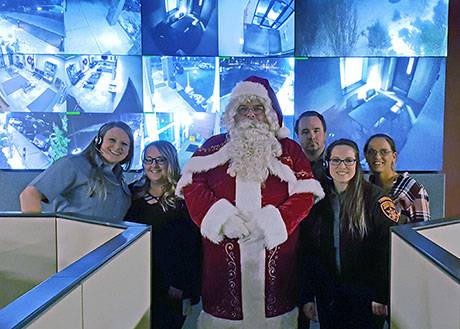
Even emergency dispatchers have Christmas wishes so yesterday Santa paid the 9-1-1 crew a visit.
Submitted photo.

Even emergency dispatchers have Christmas wishes so yesterday Santa paid the 9-1-1 crew a visit.
Submitted photo.
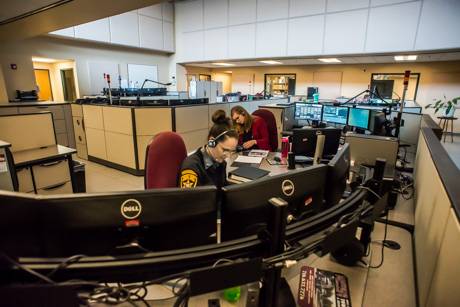
Press release:
In 1991, a formal Congressional resolution acknowledged the vital role that telecommunicators play in emergency situations by proclaiming the second week in April as a week of annual recognition in their honor. National Public Safety Telecommunicators’ Week is a time to thank these men and women who have dedicated their lives to serving the public.
The Genesee County Sheriff’s Office recognizes and commends the County’s 9-1-1 dispatchers for their dedication, professionalism and commitment to public service.
9-1-1 dispatchers are there 24/7, 365 days a year for first responders and the public in time of need. Many people do not think about these seemingly nameless, faceless individuals until they experience actual emergencies themselves. In many instances, 9-1-1 dispatchers make the difference between life and death.
More than 93,000 events were dispatched in 2017, a daily average of 255, and more than 120,000 telephone calls were handled last year, which is an average of 329 calls per day.
The Genesee County Emergency Dispatch Center (Public Safety Answering Point-PSAP) is comprised of 24 men and women who dispatch to five local police agencies/New York State Police; 19 fire departments/Emergency Management Service; threee ambulance services; as well as 41 other local, county, regional, state and federal agencies.
The Genesee County Sheriff’s Office recognizes these public safety professionals who have worked so hard during this past year. Every day citizens depend on the skill, expertise and commitment of the 9-1-1 dispatchers. They are the first to take that phone call; the first to provide basic life support in a medical emergency; and also the first to dispatch needed fire, police or EMS responders for the call.
They are to be recognized and commended.
Photos by Howard Owens.
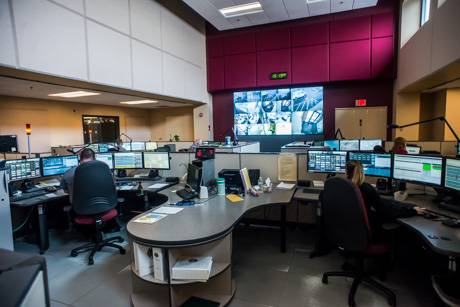
The non-emergency numbers for the Genesee County Dispatch Center are back in service.
You can call non-emergency numbers for local law enforcement contacts.
For an emergency, dial 9-1-1.
Non-emergency phone numbers for the 9-1-1 Center are currently not working.
You can still phone in an emergency by dialing 9-1-1, but if you're trying to reach a dispatcher, or Batavia PD, or Le Roy PD, or the Sheriff's Office, with a non-emergency call, the usual numbers are not working.
Batavia PD can be contacted for non-emergencies at (585) 345-6351. The administrative lines are (585) 345-6444.
Le Roy PD and the Sheriff's Office can be reached at (585) 343-5000.
However, if you have an emergency, dial 9-1-1.
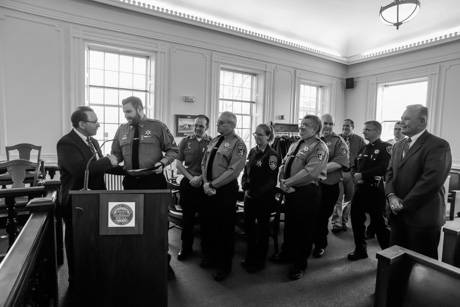
Six supervisors from the Genesee County Emergency Dispatch Center were on hand at the opening of the County Legislature meeting yesterday evening to accept a proclamation from Chairman Ray Cianfrini declaring April 9-15 as National Public Safety Telecommunications Week.
Cianfrini said the proclamation recognizes the hard work and dedication of Genesee County's emergency dispatchers.
Take the six hours between noon and 6 p.m. on Wednesday and Genesee County dispatchers handled more calls for service, 428, than any other full day in the known history of emergency dispatch for the county.
And that's just six hours.
For the full day, dispatchers received 620 calls for service. There were 706 dispatch events, 507 9-1-1 calls, 597 seven-digit emergency calls, 12,350 monitored radio transmissions, 38,953 total radio transmissions and the on-air time for dispatchers was 36 hours and three minutes. (Calls for service does not include canceled calls or consolidated calls. Monitored radio transmissions do not include transmissions to highway departments, public works and other talk groups not normally monitored by dispatch.)
Wednesday, of course, was the day Genesee County got hit with a windstorm that may have included gusts up to 80 mph. As a result, more than 12,000 National Grid customers locally were left without electricity, trees were downed, trucks were overturned and homes were damaged.
There was also a four-unit apartment fire in Batavia, a pellet stove fire in Pavilion, and a train derailment east of Donahue Road.
"It was definitely the busiest day in the entire history of emergency dispatch," said Steven Sharpe, director of emergency communications. "It was definitely a hectic room, but we have some extraordinary people so we're not running around with heads cut off. We have our heads down, plowing ahead and taking care of business as each call came in. It was very business-like but we worked our way through it."
A normal shift of three or four people swelled quickly to 11 dispatchers in the communications center on Park Road as the calls came flooding in for reports of power lines down, arcing and sparking wires, accidents and the normal medical emergencies.
"It started off like any other day, then one thing leads to another and it starts adding up," said Sgt. Jason Holman, that day's dispatch center supervisor.
One of the more experienced dispatchers in the center as winds started to kick up was Nate Fix.
"I personally worked the ice storm of 2006 and the tornado in 2009 and we've had some tough, large storms, but I've never seen that many calls and dispatches," Fix said.
Sharp, who working with Russ Lang as kind of floater support in dispatch, Holman and Fix all described a nonstop call volume that didn't let up from minute-to-minute for the duration of the storm.
The storm combined intensity and duration to make for a very busy day for dispatchers.
Sheriff William Sheron said he was really proud of the job dispatchers did during the storm.
The fire at 404 S. Jackson at 10:30 a.m. struck just as winds started to pick up, but before their full force hit the county.
"When that came in, there wasn't a real relation for us to the wind," Holman said. "The process was more day-to-day operations and you get through it and you make sure everyone responding has the information they need to know."
Winds didn't get strong until after the fire was pretty much out.
Then came the train derailment.
Russ Lang took the call, but Nate Fix was working Sheriff's dispatch so he was the first to notify patrols.
He put the word out in a single sentence, calm and in control, but knowing an incident like that could be bad.
"My dad was the Corfu chief in '94," Fix said, recalling the most recent train derailment in the county. "I remember the tones going off and it was still dark outside. I was 12 or 13 and I probably shouldn't have gone on the call, but I rode along with him and I remember people walking out of the woods in the fog. My first instinct (on this call) was to make sure there were no people involved. There wasn't, so that changed my thinking. We don't need ambulances. We just need people there to check if anything is leaking."
With the wind, Fix said, we're fortunate there was nothing toxic on the train, because the wind would have carried it right into the city.
"A lot of things go through your mind when a call like that comes in," Holman said.
Fortunately, the train derailment was nothing more than a property-damage accident, but that was still near the start of a multi-hour effort to field all the calls coming in.
Holman said, though, for all the work and all the stress on dispatchers, the real burden of the day was on the deputies, troopers, firefighters, medics, and highway personnel who actually had to respond to all those calls for service.
"We do our part, but we've got some protection," Holman said. "We're not dealing with the hazards. We try to get the information out to them as fast as we can, so my hat goes off to those guys out in the field. When it comes down to it, we've got the easy job."
With that many calls coming in, coordination and professionally handling priorities are essential to staying on top of the call volume, both Holman and Fix said. Every call is logged in the dispatch computer and all things being equal, calls are handled in the order received, but anything that involves the potential for loss of life -- a fire, an accident with entrapment, wires trapping somebody in a car or a house, gets a priority dispatch.
Dispatchers know, Fix said, that their first priority is to take care of the people in the field and the people calling in for help. Dispatchers have to stay calm in the midst of chaos and assure callers that help will arrive as soon as possible, then calmly pass the information on to responders.
But while dispatchers are taking care of everybody else, they also have their own concerns, Fix said, as does every other emergency responder.
"...the hardest thing for any emergency worker, especially for the volunteer firefighters, is they don't know what's going on with their own families because they’re going nonstop with no time to think of their family," Fix said. "I’m not sure people understand that or appreciate it."
Fix noted that Genesee County was fortunate in another way -- a storm in March isn't that unusual, but one without snow or rain is. Snow or rain could have made things so much worse.
"It still just blows my mind that we got a windstorm in March and no snow or rain with it," Fix said. That’s just remarkable this time of year."
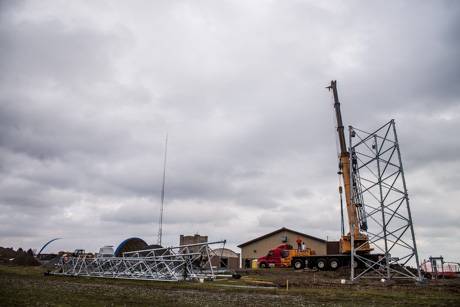
A new 165-foot communications tower is being installed today on Town of Le Roy property off of Asbury Road (the site at one time of an airport).
The tower is part of the county's upgraded 800 megahertz digital communications system and will help fill in some dead spots in the town and village of Le Roy. It will also help in spots in Le Roy where communication was harder inside of buildings.
Steven Sharpe, director of emergency communications for Genesee County said the tower will also help complete the phase of building interoperable capabilities with Monroe County's emergency dispatch center, which will then also create a bridge for communications with Ontario County.
"Our goal is to improve interoperable capabilities throughout the region," said Sharpe (in the bottom photo, taking a video of the shelter for communications equipment being lowered into place.
The tower is funded with a $3 million grant from the state.
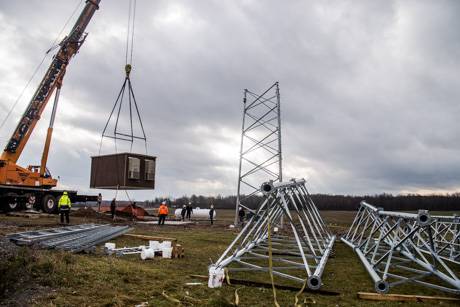
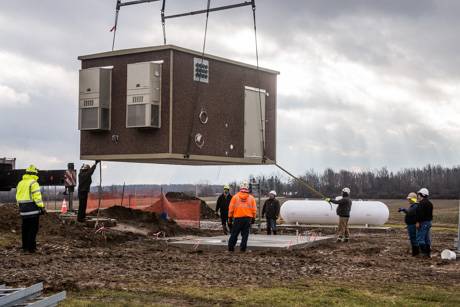
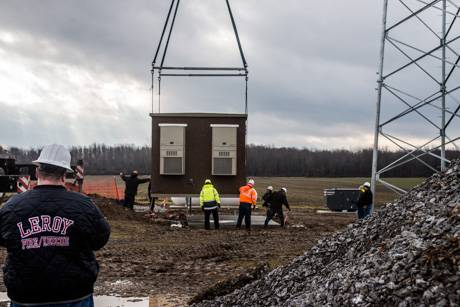
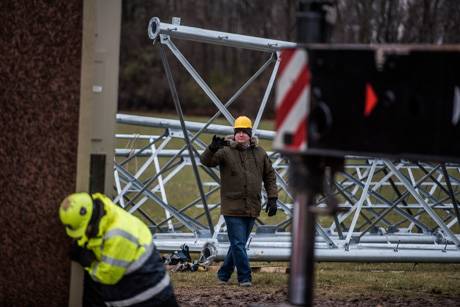
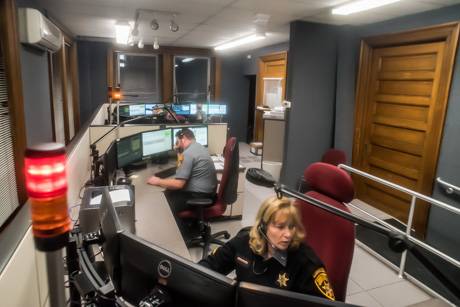
Once a year, the Sheriff's Office is required to test its backup emergency dispatch center and tonight's the night for dispatchers to work out of the location at 14 W. Main St., instead of their normal home on Park Road.
The facility is configured exactly like Park Road for an easy transition from one location to the other.
The backup facility would be used if Park Road couldn't be used for some reason.
The room in the old Sheriff's Office on West Main was the dispatch center for the Sheriff's Office for decades before the Park Road office was built.
These days, emergency dispatchers handle all traffic in the county for the Sheriff's road patrols, Batavia PD, Le Roy PD, State Police and the fire departments.
Dispatchers handle somewhere in the neighborhood of 30,000 calls for service annually.
When the county implemented a new, all-digital emergency communication system two years ago, it wasn't long before first responders in Le Roy discovered there were dead spots in their community.
There were also buildings in Le Roy that the radio signals wouldn't penetrate.
Consultants were consulted and they did their studies and came to the conclusion that Le Roy needed its own repeater transmission tower.
The county has reached an agreement with the Town of Le Roy to obtain an easement on town property on Asbury Road to build a new communications tower.
Steven Sharpe, director of Emergency Communications, said the new tower should solve Le Roy's reception problems.
The tower, the seventh in the $11-million system, is covered as part of a $3 million state grant for improvements to the system.
Construction should begin this fall, with testing to start in the spring or summer. It must be operational by December 2017.
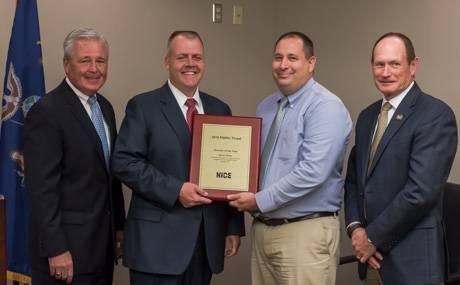
Photo, from left: Undersheriff Bill Sheron, Joseph Grube, Steve Sharpe and Sheriff Gary Maha.
Steve Sharpe, director of communications for the Genesee County Sheriff's Office, was honored yesterday with an industry award that recognizes his dedication to the profession and his job.
The PSAP (Public Safety Access Point) Finest Director of the Year award was selected by industry professionals from a national pool of nominees.
The award was sponsored by emergency communications company NICE and presented by Joseph Grube, director of public safety for Wilmac, another public safety company.
Grube said Sharp was selected based on his habits of lifelong learning, his self-motivation toward excellence, his involvement in several industry associations and groups and his advocacy for the 25 staff members who report to him in ensuring they have the best equipment and training.
“The public safety community is a better place because of people like Steve,” Grube said.
Sharp said the award really reflects what a great team he has around him, from the County Legislature that supports professional emergency communication, to the Sheriff's Office administration, to the dispatchers in the emergency dispatch center, nothing would be possible without their hard work and dedication, he said.
“I think the biggest thing people have got to understand is it's about the team," Sharpe said. "It’s always going to be about the team. It’s the people you put in the right place. It’s about learning. I’ve had some pretty spectacular failures as a leader, and I’ve had some pretty spectacular failures here in this job, but my failures were mitigated by their strengths. It all comes back to team.”
Press release:
The Genesee County Emergency Dispatch Center now offers text to 9-1-1 services. Below are a few guidelines for the use of text to 9-1-1.
Call 9-1-1 when you can, text when you can’t.
Calling 9-1-1 is always your best option as our dispatchers have a better chance of locating you and
recording background noises or conversations that can be used as evidence if you are a victim of a crime.
Text to 9-1-1 provides better access for individuals who are deaf, hard of hearing, or may have trouble
speaking especially in a mobile environment.
Text to 9-1-1 is appropriate for victims whose hiding location may be revealed by speaking on the phone.
How to text 9-1-1 in an emergency:
Enter the numbers “911” in the “To” field;
The first text message to 9-1-1 should be brief and contain the location of the emergency and type of
help needed;
Push the “Send” button (if hiding, ensure phone and text alerts are silenced).
Be prepared to answer questions and follow instructions from the 9-1-1 call taker.
Text in simple words – do not use abbreviations or emoticons.
Keep text messages brief and concise.
Below are a few things to know if you need to text 9-1-1:
Text location information is not equal to current location technology.
As with all text messages, 9-1-1 messages can take longer to receive, can get out of order or may not
be received; this may significantly delay response times.
Text-to-9-1-1 is not available if you are roaming.
A text or data plan is required to place a text-to-9-1-1.
If texting to 9-1-1 is not available in your area, or is temporarily unavailable, you will receive a message
indicating that texting 9-1-1 is not available and to contact 9-1-1 by other means.
Photos and videos cannot be sent to 9-1-1 at this time.
Text-to-9-1-1 cannot include more than one person. Do not send your emergency text to anyone other
than 9-1-1.
Do not text and drive!
Prank calling or texting 9-1-1 can be considered falsely reporting an incident or aggravated harassment; you may be arrested and prosecuted for abusing the 9-1-1 system.
Additional information regarding text to 9-1-1 can be found at the Web address immediately below: http://www.nena.org/?page=textresources
Press release:
In 1991, a formal Congressional resolution acknowledged the vital role that telecommunicators play in emergency situations by proclaiming the second week in April as a week of annual recognition in their honor. National Public Safety Telecommunicator Week is a time to thank these men and women who have dedicated their lives to serving the public.
The Genesee County Sheriff’s Office recognizes and commends the County’s 9-1-1 dispatchers for their dedication, professionalism and commitment to public service.
9-1-1 dispatchers are there 24/7,365 days a year for first responders and the public in time of need. Many people do not think about these seemingly nameless, faceless individuals until they experience actual emergencies themselves. In many instances, 9-1-1 dispatchers make the difference between life and death.
More than 82,000 events were dispatched in 2015, a daily average of 224, and 134,937 telephone calls were handled last year, which is an average of 369 calls per day. The Genesee County Emergency Dispatch Center (Public Safety Answering Point-PSAP) is comprised of 24 men and women who dispatch to five local police agencies/New York State Police; 19 fire departments/Emergency Management Service; three ambulance services; as well as 41 other local, county, state, regional, and federal agencies.
The Genesee County Sheriff’s Office recognizes these public safety professionals who have worked so hard during this past year. Every day, citizens depend on the skill, expertise and commitment of the 9-1-1 dispatchers. They are the first to take that phone call; the first to provide basic life support in a medical emergency, and also the first to dispatch needed fire, police or EMS responders for the call. They are to be recognized and commended.
The state will provide Genesee County with another $3 million to help improve its year-old $11 million emergency radio communications system, built and provisioned by RF Harris, of Rochester.
The grant will be used to fund a seventh microwave tower for the county, most likely somewhere in Le Roy, which reportedly has had some of the biggest communications black holes since the new radio system was put online.
The grant will also be used to complete interoperability connections with Monroe and Orleans counties, said County Manager Jay Gsell.
Interoperability is one of the primary goals of the Department of Homeland Security in pushing local jurisdictions to go to all-digital, Phase II, systems. With all local jurisdictions on the same radio systems, it's expected that agencies will be able to more efficiently and effectively communicate with each other in mutual aid emergencies.
It's also hoped that the upgrade will provide better local communications in a system that has been plagued by emergency responder complaints since its inception, though tweaks and incremental improvements over the past year seems to have resulted in fewer complaints.
The bulk of the $11 million spent on the system so far came from state, federal and communication industry grants, with a municipal bond covering nearly half of the expense.
"This is part of helping us complete the process of putting the best radio system out there for all of our emergency radio system users, whether it's police departments, fire departments, state patrol, highway departments, anybody who is on our radio system," Gsell said. "We're trying to make sure that almost anywhere they go in the county, they're going to have very good, strong consistent communications with our 800-MHz radios."
The $3 million is part of $50 million being awarded to local jurisdictions for emergency communications. Both Monroe and Livingston counties are receiving $3.5 million. Erie County is getting $1.2 million. There was no grant money announced for Wyoming County.
Our news partner WBTA AM/FM conducted the interview with Jay Gsell.
Press release:
April 13 – 19 is National Public Safety Telecommunicators Week and the Genesee County Sheriff’s Office recognizes and commends the County’s 9-1-1 dispatchers for their dedication, professionalism and commitment to public service.
9-1-1 dispatchers are there 24/7,365 days a year for first responders and the public in time of need. Many people don’t think about these seemingly nameless, faceless individuals until they experience actual emergencies themselves. In many instances, 9-1-1 dispatchers make the difference between life and death.
The Genesee County Sheriff’s Office recognizes these public safety professionals who have worked so hard during this past year. Every day, citizens depend on the skill, expertise and commitment of the 9-1-1 dispatchers. They are the first to take that phone call, the first to provide basic life support in a medical emergency, and also dispatch needed fire, police or EMS responders for the call. They are to be recognized and commended.
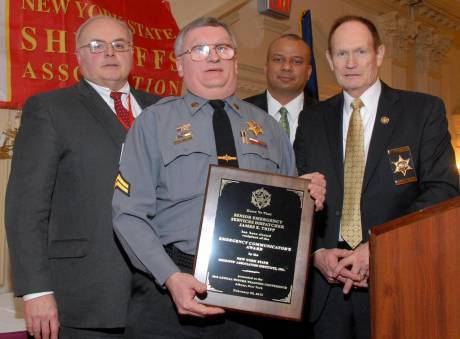
Press release:
Genesee County Senior Emergency Services Dispatcher James E. Tripp has been selected by the New York State Sheriffs’ Association Institute to receive its 2014 “Emergency Communicators Award.” The award was presented to Senior Dispatcher Tripp at the New York State Sheriffs’ Association Conference held in Albany this week.
Senior Dispatcher Tripp was nominated by Genesee County Sheriff Gary T. Maha because he has exhibited an exceptional degree of dedication and commitment to the professional fulfillment of his duties during his 21 years of service. Senior Emergency Services Dispatcher Tripp started his career with the Genesee County Sheriff’s Office as a part-time dispatcher on July 12, 1993. On January 6, 1996, Jim was appointed a full-time, permanent dispatcher and pursuant to a change in Civil Service Rules and Regulations, his title was changed to Emergency Services Dispatcher on June 7, 1999. On May 23, 2008, Jim was appointed a Senior Emergency Services Dispatcher.
As a Senior Emergency Services Dispatcher, Jim is in charge of a shift at the Genesee County Public Safety Answering Point (PSAP), under the supervision and administration of the Genesee County Sheriff’s Office. He is also a certified Communications Training Officer (CTO) and has trained several new dispatchers during his tenure with the Genesee County Sheriff’s Office.
Jim has also taken on additional duties over the years including: Terminal Access Coordinator for NYSPIN and the Integrated Justice Portal; PSAP Accreditation; and he serves as a Telecommunications Emergency Response Team Leader. Jim is the recipient of two Commendation Awards, one Meritorious Service Award and was twice awarded the Genesee County Sheriff’s Office Distinguished Service Award (2001 & 2011).
He is respected by his peers and colleagues and is a leader in the field of emergency dispatching. Jim and his wife, Terry, have three children and three grandchildren. Two of his children are also emergency service dispatchers with the Genesee County Sheriff’s Office.
Every evening the on-duty fire dispatcher comes on-air at 1800 hours with a time check, temperature and any fire service announcements.
Tonight the dispatcher informed us "current temperature is 91 degrees," but as soon as the words were out of her mouth, she corrected herself.
"Nine degrees."
Wishful thinking, maybe?
Complaints from law enforcement and fire personnel about the new Harris radio system have gone way down over the past several months, Undersheriff Bill Sharon said, but there are still issues that need to be addressed.
To that end, the Public Service Committee is recommending the County Legislature approve a $41,000 contract with Pericle Communications Co., of Colorado Springs, Colo., to conduct a transmission interference study and make recommendations for improvements.
The aim of the study will be to identify what might exist in the county that causes interference with transmissions, either it's light bars on emergency vehicles or power plants, and recommend the best methods for eliminating those problems.
"As mentioned before, we didn't have the luxury of fully testing the system before we went live because of the time constraints we were under," Sheron said. "We've winnowed those problems down one-by-one-by-one and our complaints are minimal now. There are some lingering complaints, like our coverage area in Le Roy, and I'd say that's probably the top of the list right now."
Steve Sharpe, director of emergency communications, said among the interference issues Pericle will study are related to police and fire personnel inside of buildings.
The measure of adequate coverage is no more than a 10-decibel drop in the transmission inside of a structure, which is about what you would expect inside a two-story, wood-framed house with a shingle roof. The old system only had a bit more than 70-percent coverage by that standard. The new system is in the 90-percent range, but can be improved, Sharpe said.
Sheron noted that there were quite a few problems with the old system, but nobody ever complained because responders had learned to adjust to those issues. While the new system has room for improvement, it is an upgrade over the old system, he said, and no communications system will provide 100-percent coverage 100 percent of the time.
While some of the interference problems officers and firefighters experience might be isolated to small areas or specific circumstances, there are larger areas in Le Roy where Harris radios go dead.
Legislator Shelly Stein, who represents Le Roy, said she's been following the issue closely, joining meetings with the E-911 Board, Harris and the consultants, and advocating on behalf of her first responders.
She's confident things are moving in a positive direction.
"When the county moved us over to countywide dispatch, not all of the feet were pointed in the same direction," Stein said. "Today, everybody wants this to work. Our desire is to make this work for everybody. It's right at the focal point of every one of our discussions."

They call it "the Lt. Whitcomb incident," Assistant City Manager Gretchen DiFante told the City Council Monday night.
Jeff Whitcomb, a city fire officer, was leading a group of firefighters into a burning building at Ellicott and Swan streets Sept. 18 when he tried to radio critical information to his scene commander, Chief Jim Maxwell.
Whitcomb couldn't get a "grant tone."
That radio message comes from the dispatch center and signals the radio channel is clear and the responder in the field can transmit. Without it, the radio in the responder's hand is not much more than a brick.
After the meeting, Maxwell confirmed there was an issue with Whitcomb's attempt to transmit that day.
"What happened there was the lieutenant was inside and he was trying to radio out and he couldn't, so we thought it was a system failure because he couldn't get the grant tone," Maxwell said. "After we submitted the problem report we got a response back from Harris that the system worked the way it was supposed (to). We were operating at the fire ground on the same channel they dispatch on and dispatch has priority."
The inability for a firefighter in a burning building to transmit, even if only delayed by seconds, can mean the difference between life and death.
"This was a major turning point for us," DiFante said. "That's when I went to my boss and said, 'oh, boy, Mr. Molino, we've got to do something about this.' "
DiFante recognized immediately that not only were lives at stake, but as a matter of her fiduciary responsibility to taxpayers, the city faced a potentially monstrous liability issue if police officers and firefighters were saddled with a communication system that made them vulnerable in moments of crisis.
A year ago, the county switched communication systems for police and fire to a $10 million digital system designed and built by Rochester-based Harris RF.
The need for the new system was largely driven by the FCC and Homeland Security, with a goal of freeing up the frequencies used by the old system and improving interoperability between local departments on a nationwide basis.
The grant money available for the new system came with a hard deadline for launching the Harris system.
Typically, a new communications system can be tested and refined over an 18-month period, which is what Ontario County did, DiFante said.
Genesee County got no time to test its new system before the old system was shut down.
When DiFante researched the issue, she found other jurisdictions facing similar issues with the Harris system. Miami-Dade County had to buy a new system. Las Vegas is tied up in a lawsuit with Harris. Oakland PD has had trouble, including 35 minutes of downtime when President Obama was in town.
The issue, however, she said, isn't with Harris. It's the nature of digital technology. Anybody with cable TV, she said, understands that digital technology is subject to disruption.
"Digital technology is great when it works, but when it doesn't, it causes things to happen," DiFante said.
So DiFante asked her contact at Harris which agency was doing the best with the new system, and she was told, without a doubt, Ontario County.
In her first contact with a communications director in Ontario County, he had a reaction she found common during her research -- those poor people in Genesee County.
"You know what he said -- everybody says the same thing when you tell them you're from Genesee County, 'you know what Gretchen, those poor people over in Genesee County and what they had to do,' " DiFante said.
From Ontario County, she was given the name of a consultant whom Harris is now paying to help the county resolve some of the issues facing the system.
This research, she said, led to the City Fire Department changing its communication protocol.
The volunteer departments in the county are going to the same procedure.
It won't be until March, DiFante said, before all the radios are reprogrammed.
The new system will require scene commanders to carry two radios. One will be used for communicating with dispatch. The other will be tuned to an analog tactical channel, which will be the channel used by firefighters use to communicate with each other while at a fire scene.
There will no longer be an issue with dispatch communications taking priority on the same channel with firefighter-to-firefighter communication.
There remain issues with the system DiFante said, though things have improved dramatically for both the police department and fire department over the past several months.
"We're very close to resolution," DiFante said. "What's happened since October is exciting. I can sleep better at night. This is the only thing that has kept me awake at night since I started my job."
Chief Shawn Heubusch agreed that when the new radio system was first introduced, he was troubled by the communications issues and concerned about the safety of his officers.
"There are some issues, as with any new product that is out there," Heubusch said. "It's constantly being tweaked. As she mentioned, it takes 18 months to vet these things. We didn't have that kind of time, so to put one consultant's words out there, 'we watched sausage being made.' Nobody wants to see sausage being made."
While DiFante held up folders full of trouble reports filed by the city with the county about the radio system, Heubusch said most of those trouble reports were filed months ago.
"They've made great strides in correcting the issues," Heubusch said.
Sheriff Gary Maha confirmed this morning that the county has not received a trouble report from the city since November.
Every radio system has its own issues, Heubusch said. The old system had dead spots in the city, and going back even further, when dispatch was handled by City PD, officers knew there were certain buildings -- such as the Harvester complex -- where they would be out of radio contact while inside.
"There are certain inherent dangers to public safety work that we kind of just take for granted, that we understand are out there," Heubusch said. "Digital technology has come a long way since it was implemented and again we are working on the issues that are in play with this system now and they've made great strides in making our officers and fire officers much safer."
There are issues, DiFante said, with gain control and voice fluctuations.
She also said there are still significant issues with coverage areas in Le Roy, but declined during her presentation to go into detail.
We spoke with Chief Chris Hayward, Le Roy PD, this morning and he confirmed there are ongoing issues that the county and Harris are working diligently to try and resolve.
There's one section of the village and some sections of the Town of Le Roy where the radios don't work well.
With the old system, the county had three antenna towers. The new system has six. One is on Cedar Street in Batavia, three are on the west end of the county, and there is one in Bergen and another in Pavilion.
There isn't a tower in the middle of the east side of the county.
A solution to Le Roy's dead-spot issue might be constructing a tower on Asbury Road.
Putting in a repeater at that location was the solution in the 1990s when Le Roy PD and Fire had reception issues with the old system.
Harris is running tests this week to try and identify any technology in the area that might be creating interference. At one time, there was concern that the LED lights on police cars were causing interference, but that has been ruled out, Hayward said.
As for using a tac channel for firefighters, he said the Le Roy Fire Department came upon that solution to its communication issues soon after the new radios were operational.
Hayward said he understands the county was put in this situation through no fault of its own and believes all involved are working to make things right.
"Hindsight is 20/20 and you can always ask, 'Why didn't think of this or why didn't think of that?' but I think they did a pretty good job of thinking ahead," Hayward said.
Heubusch also expressed confidence that everything possible is being done to ensure the county has a safe and reliable communications system for its emergency responders.
"It's the number-one priority with the county," Heubusch said. "It's the number-one priority with the city. It's the number-one priority with Harris -- keep everybody out there safe."
DiFante's presentation was only a portion of her 40-minute talk in front of City Council, which was really about all of the work she's done since becoming assistant city manager.
Her overall responsibilities include overseeing administrative services, including finance, the clerk-treasure, personnel, information technology, the youth bureau and assessment; as well as programs such as the community rating system and insurance, with additional projects such as how to handle a burgeoning population of feral cats, the Redfield gateway and strategic planning.
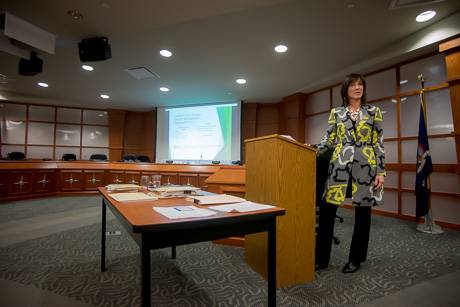
A segment from The Batavian's news partner 13WHAM focuses on the high call volume to the Genesee County Emergency Dispatch Center over the past couple of days.
On average the dispatch center receives 575 calls in a 24-hour period. Those numbers nearly tripled during Tuesday's snow storm to 1,550 calls.
On Thursday, they received nearly a day's worth of calls in half the time. Senior Emergency Services Dispatcher Jason Holman said:
"We dealt with a lot of vehicles off the road, vehicles that were stuck, motorists who were stranded in their vehicles. So the snow has caused a hazard to the folks out there.
"...The increase in mental stress, mental fatigue is something that we're working with and through, and like I said, we're more than capable of doing that and happy to do our part."
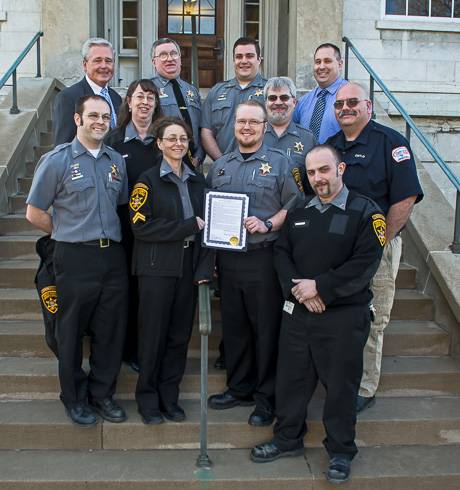
Genesee County's emergency dispatchers were honored this evening by the the County Legislature for their service to local residents as part of National Public Safety Telecommunicators’ Week. The dispatchers were presented with a resolution honoring their work.
Undersheriff Bill Sheron told legislators, "They are the lifeline of Genesee County. They handle life and death everyday." Chairman Ray Cianfrini thanked them for their dedicated service.
Photo, bottom row from left: Robert Tripp, Beth Hynes-Fisher, Adam Miller, Nathan Fix, Lynn Riccobono, Daniel Rieks, Bill Sheron, John Spencer II, Jim Tripp, Jason Holman, Steve Sharpe.
Not pictured: Barbara Eddy, Michael Sheflin, Frank Riccobono, Steve Robinson, Steve Smelski, Peggy Richardson, Kelly Tripp, James Sheflin, Andy Merkel, Jenna Bauer and Zackery Czudak.
Copyright © 2008-2022 The Batavian. All Rights Reserved. Privacy Policy | Terms of Service